Analysis of the Ionospheric Response to Sudden Stratospheric Warming and Geomagnetic Forcing over Europe during February and March 2023
Abstract
1. Introduction
2. Data and Methods
2.1. Parameters, Describing the Geomagnetic Storm
2.2. Ionospheric Parameters from GIRO
2.3. TEC Data
3. Results
3.1. Stratospheric Warming and Solar and Geomagnetic Influences on Ionospheric TEC in February and March 2023
3.2. Ionospheric Response during Geomagnetic Storm
3.2.1. Variations of Geomagnetic and Solar Parameters during the Geomagnetic Storm on 26–27 February 2023
3.2.2. Ionospheric Variations in the Initial Phase of the Storm
3.2.3. Ionospheric Variations during the Main Phase of the Storm
4. Discussion and Conclusions
Author Contributions
Funding
Data Availability Statement
Acknowledgments
Conflicts of Interest
References
- Rishbeth, H. F-region storms and thermospheric dynamics. J. Geomagn. Geoelectr. 1991, 43, 513–524. [Google Scholar] [CrossRef]
- Werner, S.; Bauske, R.; Prolss, G.W. On the origin of positive ionospheric storms. Adv. Space. Res. 1999, 24, 1485–1489. [Google Scholar] [CrossRef]
- Mikhailov, A.; Schlegel, K. Physical mechanism of strong negative storm effects in the daytime ionospheric F2 region observed with EISCAT. Ann. Geophys. 1998, 16, 602–608. [Google Scholar] [CrossRef][Green Version]
- Fuller-Rowell, T.J.; Codrescu, M.V.; Moffett, R.J.; Quegan, S. Response of the thermosphere and ionosphere to geomagnetic storms. J. Geophys. Res. Space Phys. 1994, 99, 3893–3914. [Google Scholar] [CrossRef]
- Danilov, A.D.; Lastovicka, J. Effects of geomagnetic storms on the ionosphere and atmosphere. Int. J. Geomagn. Aeron. 2001, 2, 209–224. [Google Scholar]
- Rishbeth, H. How the thermospheric circulation affects the ionospheric F2-layer. J. Atmos. Sol.-Terr. Phys. 1998, 60, 1385–1402. [Google Scholar] [CrossRef]
- Astafyeva, E.; Bagiya, M.S.; Förster, M.; Nishitani, N. Unprecedented hemispheric asymmetries during a surprise ionospheric storm: A game of drivers. J. Geophys. Res. Space Phys. 2020, 125, e2019JA027261. [Google Scholar] [CrossRef]
- Wang, Z.; Zou, S.; Liu, L.; Ren, J.; Aa, E. Hemispheric Asymmetries in the Mid-latitude Ionosphere During the September 7–8, 2017 Storm: Multi-instrument Observations. J. Geophys. Res. Space Phys. 2021, 126, e2020JA028829. [Google Scholar] [CrossRef]
- Zhai, C.; Cai, X.; Wang, W.; Coster, A.; Qian, L.; Solomon, S.; Yu, T.; He, M. Mid-Latitude Ionospheric Response to a Weak Geomagnetic Activity Event During Solar Minimum. J. Geophys. Res. Space Phys. 2023, 128, e2022JA030908. [Google Scholar] [CrossRef]
- Balan, N.; Liu, L.; Le, H. A brief review of equatorial ionization anomaly and ionospheric irregularities. Earth Planet. Phys. 2018, 2, 257–275. [Google Scholar] [CrossRef]
- Karan, D.K.; Eastes, R.W.; Daniell, R.E.; Martinis, C.R.; McClintock, W.E. GOLD mission’s observation about the geomagnetic storm effects on the nighttime equatorial ionization anomaly (EIA) and equatorial plasma bubbles (EPB) during a solar minimum equinox. Space Weather 2023, 21, e2022SW003321. [Google Scholar] [CrossRef]
- Wu, K.; Qian, L.; Wang, W.; Cai, X.; Mclnerney, J.M. Investigation of the GOLD observed merged nighttime EIA with WACCM-X simulations during the storm of 3 and 4 November 2021. Geophys. Res. Lett. 2023, 50, e2023GL103603. [Google Scholar] [CrossRef]
- Astafyeva, E.; Yasyukevich, Y.V.; Maletckii, B.; Oinats, A.; Vesnin, A.; Yasyukevich, A.S.; Syrovatskii, S.; Guendouz, N. Ionospheric disturbances and irregularities during the 25–26 August 2018 geomagnetic storm. J. Geophys. Res. Space Phys. 2022, 127, e2021JA029843. [Google Scholar] [CrossRef]
- Bojilova, R.; Mukhtarov, P. Comparative Analysis of Global and Regional Ionospheric Responses during Two Geomagnetic Storms on 3 and 4 February 2022. Remote Sens. 2023, 15, 1739. [Google Scholar] [CrossRef]
- Goncharenko, L.P.; Coster, A.J.; Chau, J.L.; Valladares, C.E. Impact of sudden stratospheric warmings on equatorial ionization anomaly. J. Geophys. Res. Space Phys. 2010, 115, A00G07. [Google Scholar] [CrossRef]
- O’Neill, A. Stratospheric sudden warmings. In Encyclopedia of Atmospheric Sciences; Holton, J.R., Pyle, J.A., Curry, J.A., Eds.; Elsevier: New York, NY, USA, 2003; pp. 1342–1353. [Google Scholar]
- Goncharenko, L.; Zhang, S.R. Ionospheric signatures of sudden stratospheric warming: Ion temperature at middle latitude. Geophys. Res. Lett. 2008, 35, L21103. [Google Scholar] [CrossRef]
- Pancheva, D.; Mukhtarov, P. Stratospheric warmings: The atmosphere–ionosphere coupling paradigm. J. Atmos. Sol.-Terr. Phys. 2011, 73, 1697–1702. [Google Scholar] [CrossRef]
- Lin, J.T.; Lin, C.H.; Chang, L.C.; Huang, H.H.; Liu, J.Y.; Chen, A.B.; Chen, C.H.; Liu, C.H. Observational evidence of ionospheric migrating tide modification during the 2009 stratospheric sudden warming. Geophys. Res. Lett. 2012, 39, L02101. [Google Scholar] [CrossRef]
- Oyama, K.I.; Jhou, J.T.; Lin, J.T.; Lin, C.; Liu, H.; Yumoto, K. Ionospheric response to 2009 sudden stratospheric warming in the Northern Hemisphere. J. Geophys. Res. Space Phys. 2014, 119, 10260–10275. [Google Scholar] [CrossRef]
- Mukhtarov, P.; Pancheva, D. Winter-time dependence of the global TEC on the stratospheric temperature and solar radiation. J. Atmos. Sol.-Terr. Phys. 2015, 136, 134–149. [Google Scholar] [CrossRef]
- Pedatella, N.M. Impact of the lower atmosphere on the ionosphere response to a geomagnetic superstorm. Geophys. Res. Lett. 2016, 43, 9383–9389. [Google Scholar] [CrossRef]
- Vijaya, G.; Arumugam, S. Monitoring the stability of the processes in defined level software companies using control charts with three sigma limits. WSEAS Trans. Inf. Sci. Appl. 2010, 7, 1230–1239. [Google Scholar]
- Ciraolo, L.; Azpilicueta, F.; Brunini, C.; Meza, A.; Radicella, S.M. Calibration errors on experimental slant total electron content (TEC) determined with GPS. J. Geod. 2007, 81, 111–120. [Google Scholar] [CrossRef]
- Schaer, S. Mapping and Predicting the Earths Ionosphere Using the Global Positioning System. Ph.D. Thesis, University of Bern, Bern, Switzerland, 1999; p. 205. [Google Scholar]
- Chau, J.L.; Goncharenko, L.P.; Fejer, B.G.; Liu, H.L. Equatorial and low latitude ionospheric effects during sudden stratospheric warming events: Ionospheric effects during SSW events. Space Sci. Rev. 2012, 168, 385–417. [Google Scholar] [CrossRef]
- Goncharenko, L.; Chau, J.L.; Condor, P.; Coster, A.; Benkevitch, L. Ionospheric effects of sudden stratospheric warming during moderate-to-high solar activity: Case study of January 2013. Geophys. Res. Lett. 2013, 40, 4982–4986. [Google Scholar] [CrossRef]
- Fang, T.W.; Fuller-Rowell, T.; Akmaev, R.; Wu, F.; Wang, H.; Anderson, D. Longitudinal variation of ionospheric vertical drifts during the 2009 sudden stratospheric warming. J. Geophys. Res. Space Phys. 2012, 117, A03324. [Google Scholar] [CrossRef]
- Jonah, O.F.; De Paula, E.R.; Kherani, E.A.; Dutra, S.L.; Paes, R.R. Atmospheric and ionospheric response to sudden stratospheric warming of January 2013. J. Geophys. Res. Space Phys. 2014, 119, 4973–4980. [Google Scholar] [CrossRef]
- Sumod, S.G.; Pant, T.K.; Jose, L.; Hossain, M.M.; Kumar, K.K. Signatures of sudden stratospheric warming on the equatorial ionosphere-thermosphere system. Planet. Space Sci. 2012, 63, 49–55. [Google Scholar] [CrossRef]
- Butler, A.H.; Seidel, D.J.; Hardiman, S.C.; Butchart, N.; Birner, T.; Match, A. Defining sudden stratospheric warmings. Bull. Am. Meteorol. Soc. 2015, 96, 1913–1928. [Google Scholar] [CrossRef]
- Adebesin, B.O.; Ikubanni, S.O.; Kayode, J.S.; Adekoya, B.J. Variability of solar wind dynamic pressure with solar wind parameters during intense and severe storms. Afr. Rev. Phys. 2013, 8, 119–128. [Google Scholar]
- Laštovička, J. Effects of geomagnetic storms in the lower ionosphere, middle atmosphere and troposphere. J. Atmos. Sol.-Terr. Phys. 1996, 58, 831–843. [Google Scholar] [CrossRef]
- Blagoveshchenskii, D.V. Effect of geomagnetic storms (substorms) on the ionosphere: 1. A review. Geomagn. Aeron. 2013, 53, 275–290. [Google Scholar] [CrossRef]
- Buresova, D. Effects of geomagnetic storms on the bottomside ionospheric F region. Adv. Space. Res. 2005, 35, 429–439. [Google Scholar] [CrossRef]
- Immel, T.J.; Mannucci, A.J. Ionospheric redistribution during geomagnetic storms. J. Geophys. Res. Space Phys. 2013, 118, 7928–7939. [Google Scholar] [CrossRef] [PubMed]
- Nava, B.; Rodríguez-Zuluaga, J.; Alazo-Cuartas, K.; Kashcheyev, A.; Migoya-Orué, Y.; Radicella, S.M.; Amory-Mazaudier, C.; Fleury, R. Middle-and low-latitude ionosphere response to 2015 St. Patrick’s Day geomagnetic storm. J. Geophys. Res. Space Phys. 2016, 121, 3421–3438. [Google Scholar] [CrossRef]
- Andonov, B.; Muhtarov, P.; Kutiev, I. Analogue model, relating Kp index to solar wind parameters. J. Atmos. Sol.-Terr. Phys. 2004, 66, 927–932. [Google Scholar] [CrossRef]
- Bojilova, R.; Mukhtarov, P. Response of the electron density profiles to geomagnetic disturbances in January 2005. Stud. Geophys. Geod. 2019, 63, 436–454. [Google Scholar] [CrossRef]
- Danilov, A.D. Prestorm ionospheric disturbances: Precursors or Q-disturbances? Adv. Space Res. 2022, 69, 159–167. [Google Scholar] [CrossRef]
- Danilov, A.D.; Konstantinova, A.V. Ionospheric precursors of geomagnetic storms. 1. A review of the problem. Geomagn. Aeron. 2019, 59, 554–566. [Google Scholar] [CrossRef]
- Burešová, D.; Laštovička, J. Pre-storm enhancements of foF2 above Europe. Adv. Space Res. 2007, 39, 1298–1303. [Google Scholar] [CrossRef]
- Mikhailov, A.V.; Perrone, L. Pre-storm NmF2 enhancements at middle latitudes: Delusion or reality? Ann. Geophys. 2009, 27, 1321–1330. [Google Scholar] [CrossRef]
- Andonov, B.; Bojilova, R.; Mukhtarov, P. Global distribution of total electron content response to weak geomagnetic activity. CR Acad. Bulg. Sci. 2021, 74, 1032–1042. [Google Scholar]
- Okoh, D.; Bounhir, A.; Habarulema, J.B.; Rabiu, B.; Katamzi-Joseph, Z.; Ojo, T.; Wu, Q.; Makela, J.J. Thermospheric Neutral Wind Measurements and Investigations across the African Region—A Review. Atmosphere 2022, 13, 863. [Google Scholar] [CrossRef]
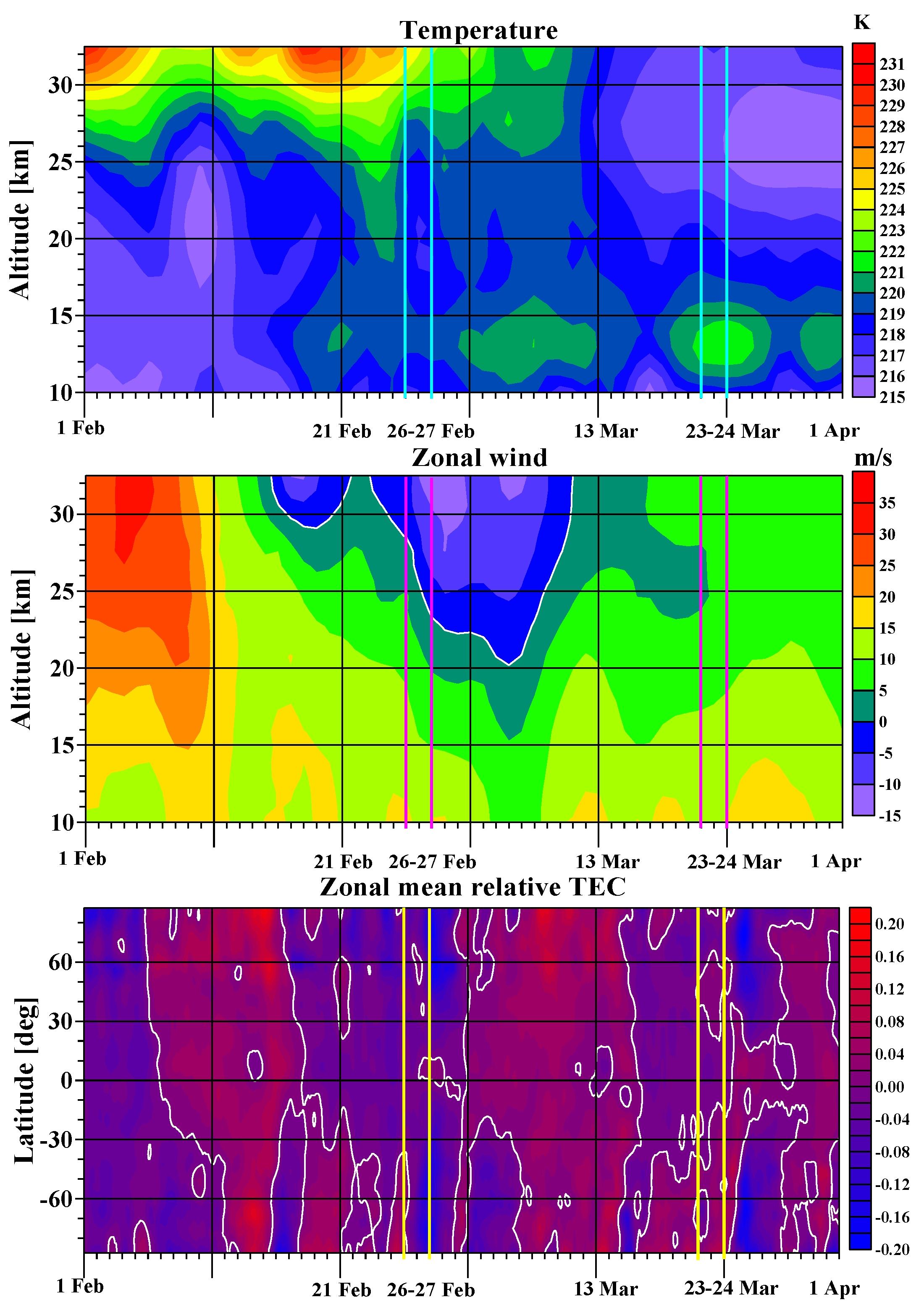
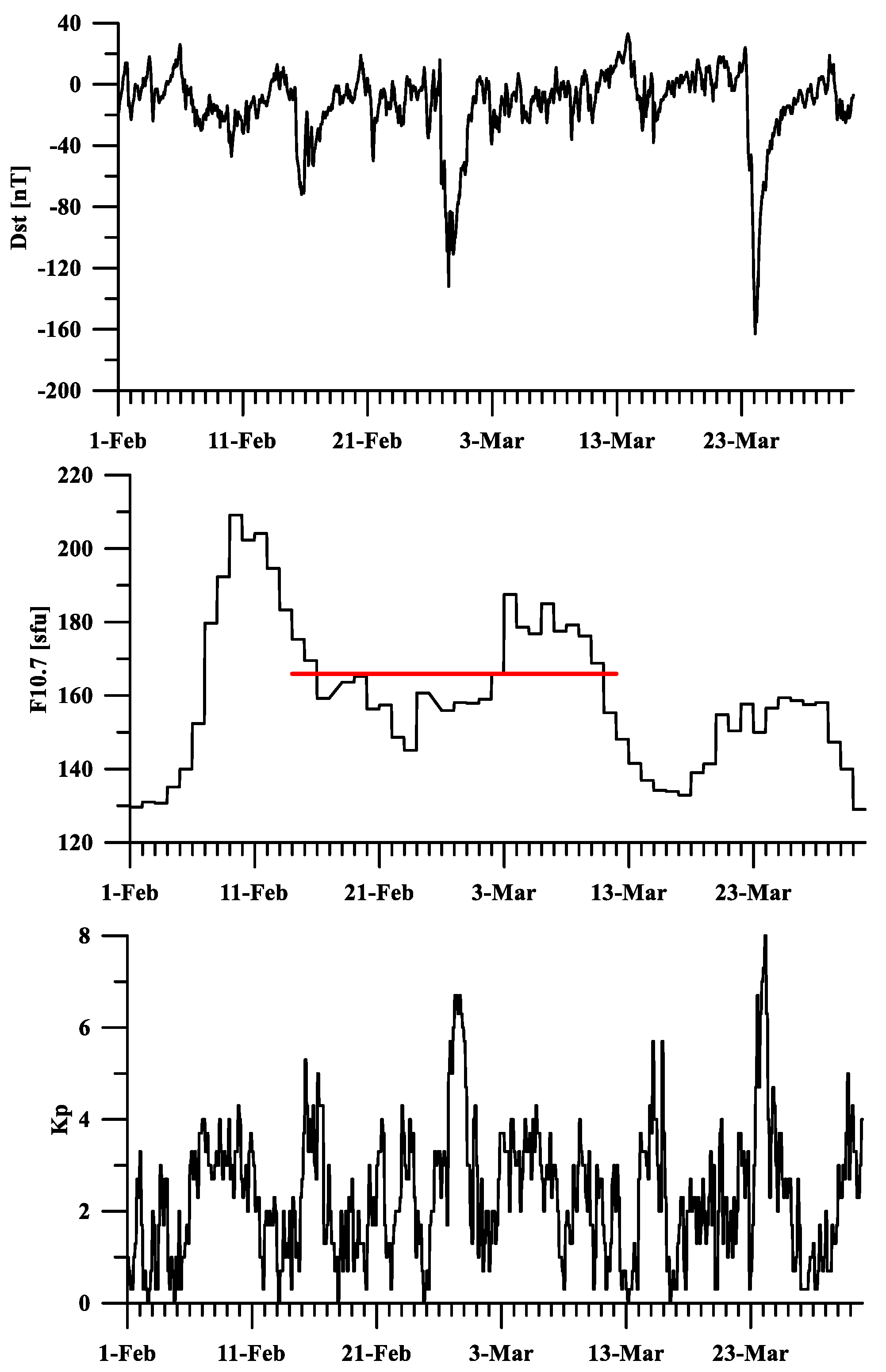
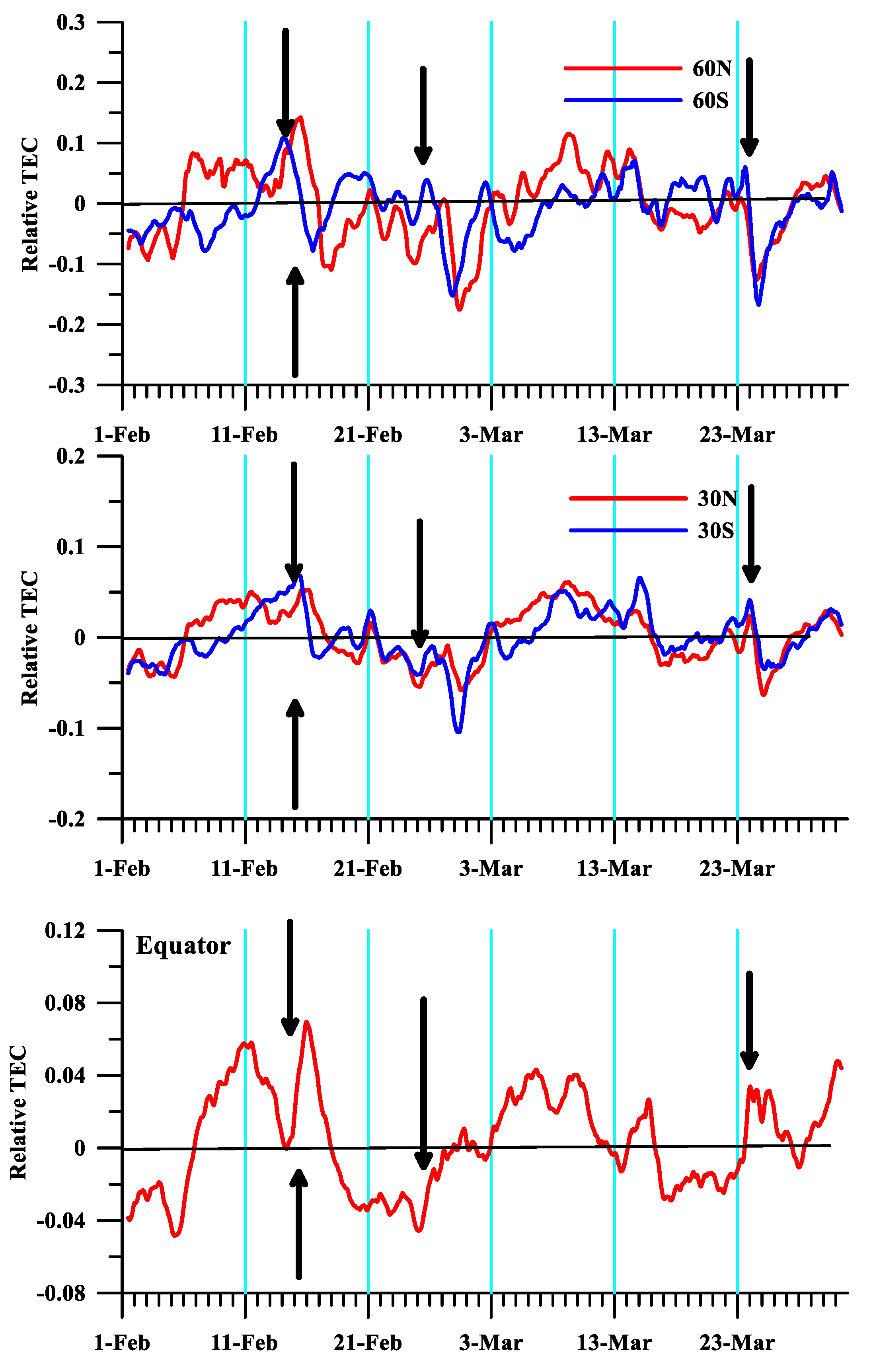

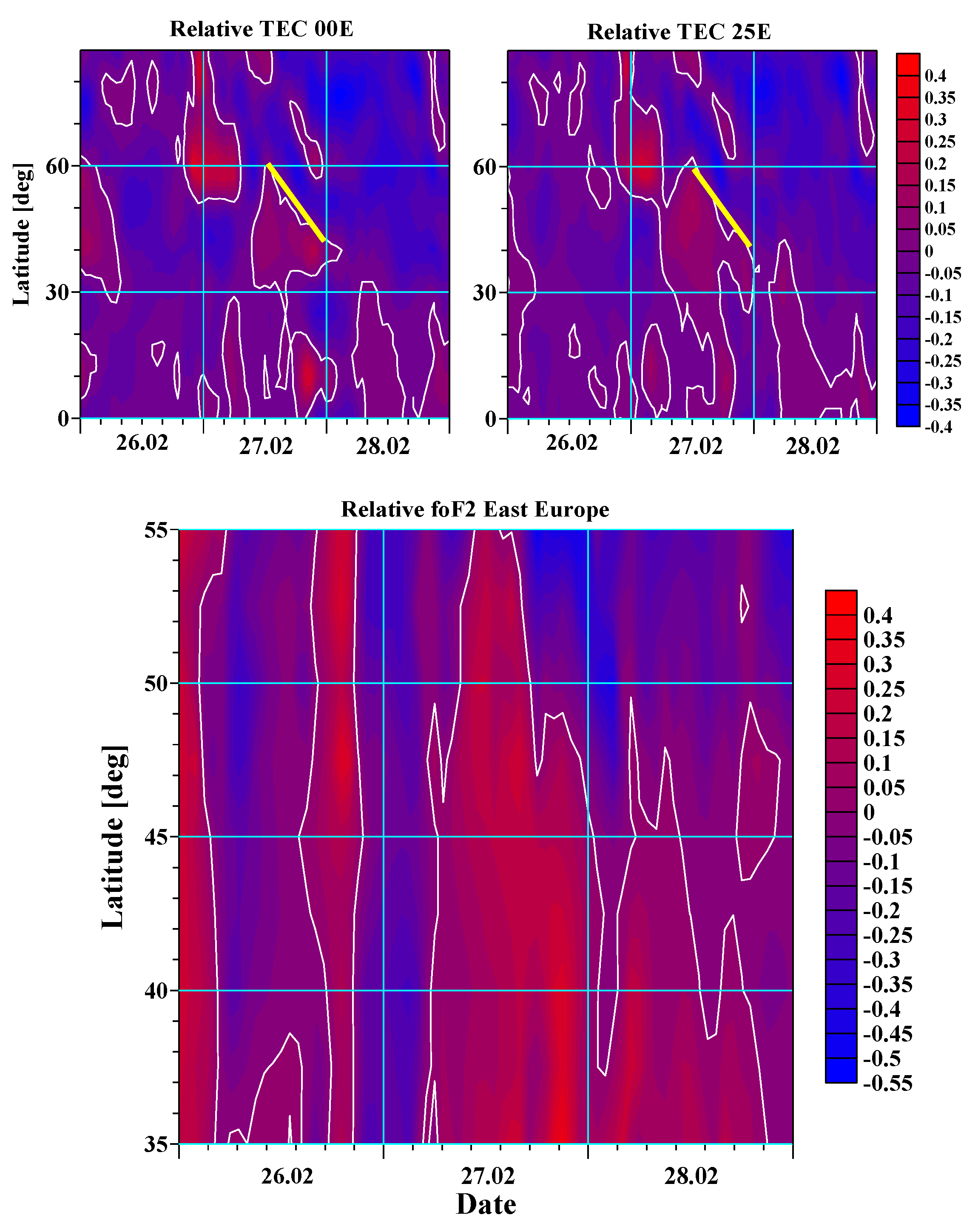
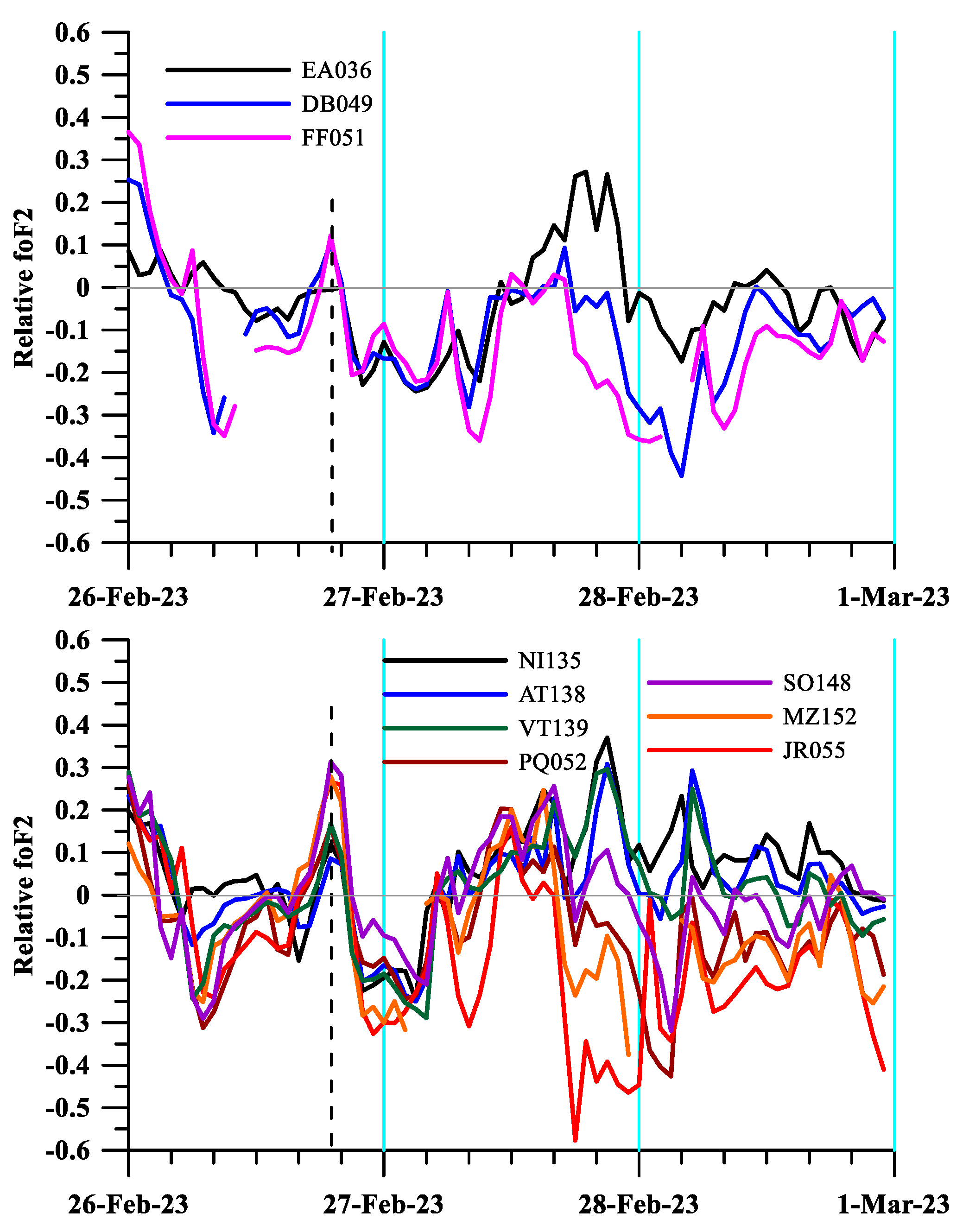


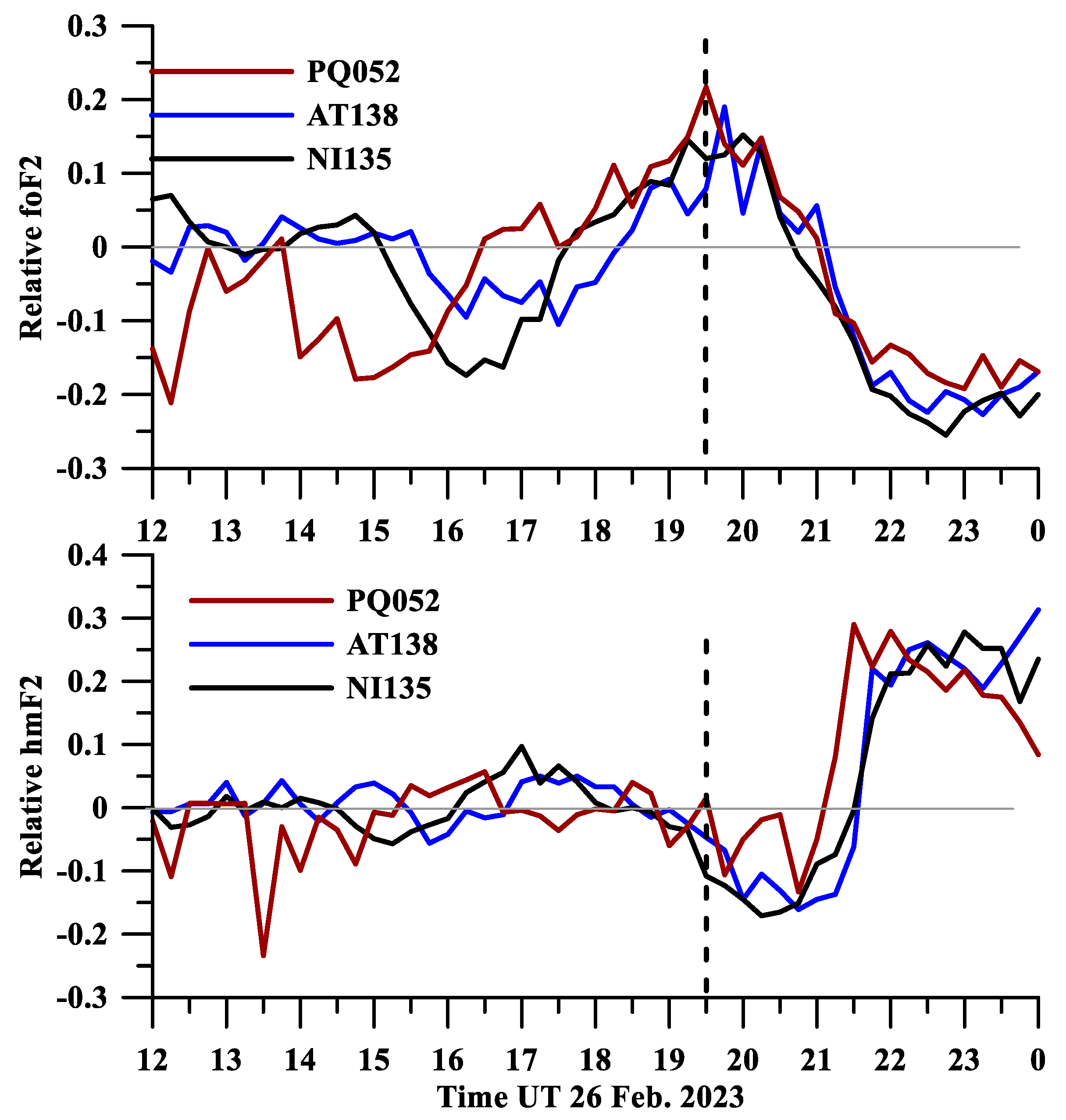
| STATION CODE | STATION NAME | LAT | LONG | MLAT | MLON |
|---|---|---|---|---|---|
| EA036 | EL ARENOSILLO | 37.1 | −6.7 | 41.4 | 72.3 |
| DB049 | DOURBES | 50.1 | 4.6 | 51.26 | 88.51 |
| FF051 | FAIRFORD | 51.7 | −1.8 | 54.3 | 82.8 |
| NI135 | NICOSIA | 35.0 | 33.2 | 31.7 | 111.0 |
| AT138 | ATHENS | 38.0 | 23.6 | 36.4 | 102.5 |
| VT139 | SAN VITO | 40.6 | 17.8 | 39.89 | 98.29 |
| SO148 | SOPRON | 47.7 | 16.1 | 45.9 | 101.3 |
| PQ052 | PRUHONICE | 50.0 | 14.6 | 49.55 | 98.23 |
| JR055 | JULIUSRUH | 54.6 | 13.4 | 54.19 | 99.03 |
Disclaimer/Publisher’s Note: The statements, opinions and data contained in all publications are solely those of the individual author(s) and contributor(s) and not of MDPI and/or the editor(s). MDPI and/or the editor(s) disclaim responsibility for any injury to people or property resulting from any ideas, methods, instructions or products referred to in the content. |
© 2023 by the authors. Licensee MDPI, Basel, Switzerland. This article is an open access article distributed under the terms and conditions of the Creative Commons Attribution (CC BY) license (https://creativecommons.org/licenses/by/4.0/).
Share and Cite
Bojilova, R.; Mukhtarov, P. Analysis of the Ionospheric Response to Sudden Stratospheric Warming and Geomagnetic Forcing over Europe during February and March 2023. Universe 2023, 9, 351. https://doi.org/10.3390/universe9080351
Bojilova R, Mukhtarov P. Analysis of the Ionospheric Response to Sudden Stratospheric Warming and Geomagnetic Forcing over Europe during February and March 2023. Universe. 2023; 9(8):351. https://doi.org/10.3390/universe9080351
Chicago/Turabian StyleBojilova, Rumiana, and Plamen Mukhtarov. 2023. "Analysis of the Ionospheric Response to Sudden Stratospheric Warming and Geomagnetic Forcing over Europe during February and March 2023" Universe 9, no. 8: 351. https://doi.org/10.3390/universe9080351
APA StyleBojilova, R., & Mukhtarov, P. (2023). Analysis of the Ionospheric Response to Sudden Stratospheric Warming and Geomagnetic Forcing over Europe during February and March 2023. Universe, 9(8), 351. https://doi.org/10.3390/universe9080351







